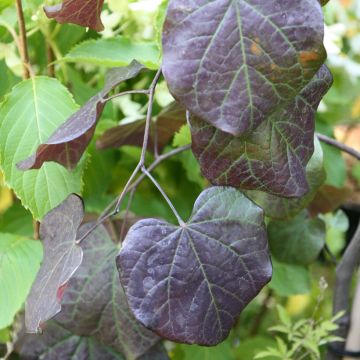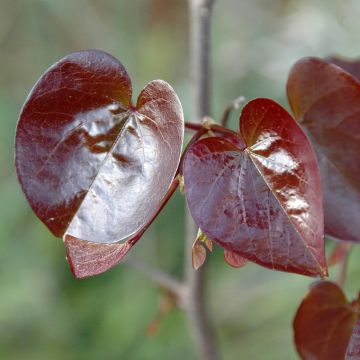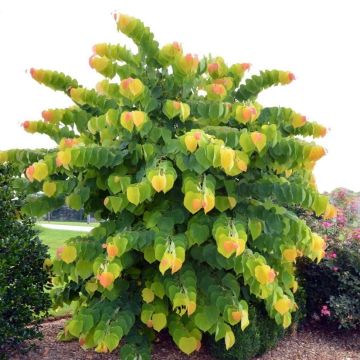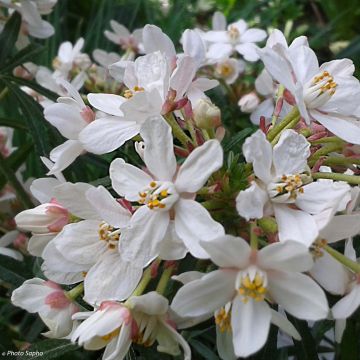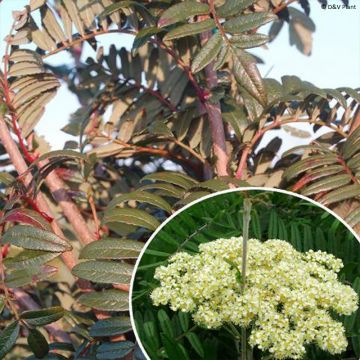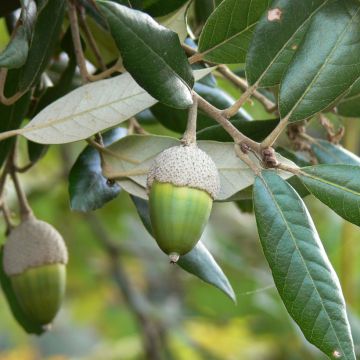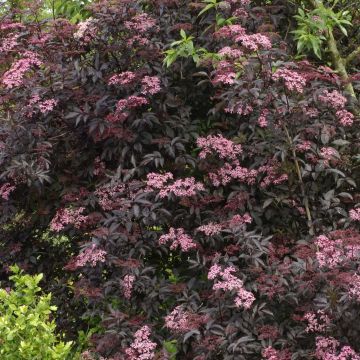

Cercis canadensis var.texensis Oklahoma - Texas Redbud
Cercis canadensis var.texensis Oklahoma - Texas Redbud
Cercis canadensis var.texensis Oklahoma
Texas Redbud, Texas Eastern Redbud
Why not try an alternative variety in stock?
View all →This plant carries a 24 months recovery warranty
More information
We guarantee the quality of our plants for a full growing cycle, and will replace at our expense any plant that fails to recover under normal climatic and planting conditions.
Oversize package: home delivery by special carrier from €6.90 per order..
Express home delivery from €8.90.
Delivery to Corse prohibited: UE law prohibits the import of this plant from mainland France to Corse as part of the fight against Xylella fastidiosa. Please accept our sincere apologies.
More information
Does this plant fit my garden?
Set up your Plantfit profile →
Description
Cercis canadensis var. texensis 'Oklahoma' is a variety of Texas Redbud selected for its particularly vibrant pink flowering and its more branched habit. This deciduous small tree is interesting for its early flowering, very shiny foliage, autumn colours and decorative purplish fruiting, which persists on the branches until winter. In the garden, it proves to be more drought-tolerant than its close relative, the classic Eastern Redbud (Cercis canadensis), and well adapted to limestone soils.
Cercis canadensis var texensis (synonym Cercis occidentalis) 'Oklahoma' belongs to the Fabaceae or Papilionaceae family. This subspecies of Eastern Redbud is native to a more western area of the United States, ranging from the mountains of southern Oklahoma to the limestone plains of central Texas, as well as from southern to northeastern Mexico. It is more stocky but also more drought-resistant than its better-known eastern cousin, the typical Eastern Redbud. Its hardiness is excellent, beyond -20 °C.
The cultivar 'Oklahoma' was discovered in 1964, growing wild in Oklahoma. It is a slow-growing tree, often wider than tall, with a short trunk topped by a low, widely branched canopy. Its average dimensions reach 4.60 metres in height and 5.30 metres in width. Of course, these parameters strongly depend on the growing conditions. The flowers appear before the leaves, in March or April, directly on the branches, even on the trunk and even those that are only one year old. They are shaped like pea flowers and are a bright magenta-pink. They are loved by pollinators, especially bumblebees. The fruits, shaped like flattened, reddish-brown pods, are present on this variety. The foliage emerges as red-purple and translucent, then intensively turns into shiny dark green, tinted with yellow and orange in autumn depending on the year and soil conditions. The leaves are thick, kidney or heart-shaped, about 6-7 cm long, and hairy underneath. The older branches and trunk have a cracked, grey-black bark. Mature specimens often have a twisted trunk and an umbrella-like canopy, giving them a Japanese silhouette.
This 'Oklahoma' Redbud is attractive 8 months out of 12. It can be used as a solitary specimen, but also in a large group composed of other small trees chosen for their flowering or decorative fruiting: ornamental crabapple trees, winged euonymus (Euonymus alatus), Lamarck's serviceberry, and European cornel, for example. It only requires fairly deep, not too clayey soil, even very limestone and rather dry in summer. This Redbud can be planted in all regions. It does not require any particular pruning: in short, it is a very accommodating plant that can thrive in any garden! It can also be striking standing out against a wall or evergreen foliage, accompanied by a 'Black Lace' Elder for colour and shape contrast. Or, with a 'Grace' Smokebush, which has summer flowering in airy plumes and sumptuous autumn foliage.
Report an error about the product description
Plant habit
Flowering
Foliage
Botanical data
Cercis
canadensis var.texensis
Oklahoma
Fabaceae
Texas Redbud, Texas Eastern Redbud
Cercis canadensis ssp. texensis , Cercis occidentalis, Cercis reniformis Oklahoma
North America
Other Cercis
Planting and care
Cercis canadensis 'Oklahoma' should be planted in early spring or early autumn, preferably in full sun. It can tolerate partial shade in the south. It is not very demanding when it comes to soil type, as long as it is somewhat deep. Highly chalky soils are not a problem, nor is summer drought once it is well established. However, this redbud tree is not suitable for heavy, clayey, sticky, suffocating soils, or very wet soils in winter. In poor soil, enrich the planting area with good compost or potting soil. Water regularly to help it establish, especially during the first two summers in case of prolonged drought. It can tolerate all types of soil except for highly acidic ones, and it prefers neutral or alkaline soils. It is hardy, but the young shoots may suffer from severe spring frost. Providing winter protection with a frost cloth can be helpful during the first few years in case of a severe cold spell in March.
Planting period
Intended location
Care
This item has not been reviewed yet - be the first to leave a review about it.
Striking foliage shrubs
Haven't found what you were looking for?
Hardiness is the lowest winter temperature a plant can endure without suffering serious damage or even dying. However, hardiness is affected by location (a sheltered area, such as a patio), protection (winter cover) and soil type (hardiness is improved by well-drained soil).

Photo Sharing Terms & Conditions
In order to encourage gardeners to interact and share their experiences, Promesse de fleurs offers various media enabling content to be uploaded onto its Site - in particular via the ‘Photo sharing’ module.
The User agrees to refrain from:
- Posting any content that is illegal, prejudicial, insulting, racist, inciteful to hatred, revisionist, contrary to public decency, that infringes on privacy or on the privacy rights of third parties, in particular the publicity rights of persons and goods, intellectual property rights, or the right to privacy.
- Submitting content on behalf of a third party;
- Impersonate the identity of a third party and/or publish any personal information about a third party;
In general, the User undertakes to refrain from any unethical behaviour.
All Content (in particular text, comments, files, images, photos, videos, creative works, etc.), which may be subject to property or intellectual property rights, image or other private rights, shall remain the property of the User, subject to the limited rights granted by the terms of the licence granted by Promesse de fleurs as stated below. Users are at liberty to publish or not to publish such Content on the Site, notably via the ‘Photo Sharing’ facility, and accept that this Content shall be made public and freely accessible, notably on the Internet.
Users further acknowledge, undertake to have ,and guarantee that they hold all necessary rights and permissions to publish such material on the Site, in particular with regard to the legislation in force pertaining to any privacy, property, intellectual property, image, or contractual rights, or rights of any other nature. By publishing such Content on the Site, Users acknowledge accepting full liability as publishers of the Content within the meaning of the law, and grant Promesse de fleurs, free of charge, an inclusive, worldwide licence for the said Content for the entire duration of its publication, including all reproduction, representation, up/downloading, displaying, performing, transmission, and storage rights.
Users also grant permission for their name to be linked to the Content and accept that this link may not always be made available.
By engaging in posting material, Users consent to their Content becoming automatically accessible on the Internet, in particular on other sites and/or blogs and/or web pages of the Promesse de fleurs site, including in particular social pages and the Promesse de fleurs catalogue.
Users may secure the removal of entrusted content free of charge by issuing a simple request via our contact form.
The flowering period indicated on our website applies to countries and regions located in USDA zone 8 (France, the United Kingdom, Ireland, the Netherlands, etc.)
It will vary according to where you live:
- In zones 9 to 10 (Italy, Spain, Greece, etc.), flowering will occur about 2 to 4 weeks earlier.
- In zones 6 to 7 (Germany, Poland, Slovenia, and lower mountainous regions), flowering will be delayed by 2 to 3 weeks.
- In zone 5 (Central Europe, Scandinavia), blooming will be delayed by 3 to 5 weeks.
In temperate climates, pruning of spring-flowering shrubs (forsythia, spireas, etc.) should be done just after flowering.
Pruning of summer-flowering shrubs (Indian Lilac, Perovskia, etc.) can be done in winter or spring.
In cold regions as well as with frost-sensitive plants, avoid pruning too early when severe frosts may still occur.
The planting period indicated on our website applies to countries and regions located in USDA zone 8 (France, United Kingdom, Ireland, Netherlands).
It will vary according to where you live:
- In Mediterranean zones (Marseille, Madrid, Milan, etc.), autumn and winter are the best planting periods.
- In continental zones (Strasbourg, Munich, Vienna, etc.), delay planting by 2 to 3 weeks in spring and bring it forward by 2 to 4 weeks in autumn.
- In mountainous regions (the Alps, Pyrenees, Carpathians, etc.), it is best to plant in late spring (May-June) or late summer (August-September).
The harvesting period indicated on our website applies to countries and regions in USDA zone 8 (France, England, Ireland, the Netherlands).
In colder areas (Scandinavia, Poland, Austria...) fruit and vegetable harvests are likely to be delayed by 3-4 weeks.
In warmer areas (Italy, Spain, Greece, etc.), harvesting will probably take place earlier, depending on weather conditions.
The sowing periods indicated on our website apply to countries and regions within USDA Zone 8 (France, UK, Ireland, Netherlands).
In colder areas (Scandinavia, Poland, Austria...), delay any outdoor sowing by 3-4 weeks, or sow under glass.
In warmer climes (Italy, Spain, Greece, etc.), bring outdoor sowing forward by a few weeks.







































